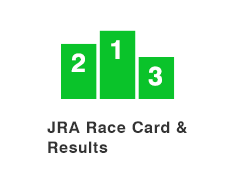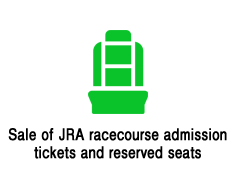2025 News
October 2025
The Japan Racing Association
Exclusive Topics for JAPAN AUTUMN INTERNATIONAL 2025 - 2nd Edition -
The impact of climate change has become a major issue in Japanese racing, requiring JRA to introduce increasingly significant measures at its facilities to counter the impact of summer heat. In one measure, implemented on a trial basis at Niigata Racecourse for two weeks between the end of July and beginning of August 2024, races were rescheduled to avoid the hottest afternoon hours. The start time for each of the five morning races was advanced by approximately 30 minutes, and then after a long break of over 3.5 hours, racing resumed at around 3:00 p.m. Each day’s final race started at 6:25 p.m., with the exception of stakes races and other major events, which continued to start at around 3:00 p.m. to accommodate television broadcast time slots.
Up to 2019, summer racing meets had been held from late July and to early September at Niigata, Sapporo and Kokura racecourses. In 2020 and 2021, to accommodate the 2020 Tokyo Olympic and Paralympic Games (postponed to 2021 due to COVID-19), summer racing at Kokura was shortened to four weeks from mid-August to the first week of September so that JRA staffers could be reassigned as organizing personnel for equestrian events. Also, Hokkaido racing was shifted to Hakodate (2021 only). The next two years, normal summer racing continued at Niigata and resumed at Sapporo, and was extended to five weeks from August to early September at Kokura. In 2024, when the split-day schedule was trialed at Niigata, summer racing continued at Sapporo, was delayed until August (four weeks) at Chukyo and moved up to June-July at Kokura.
In 2025, the split-day system (referred to by JRA as “expanded racing hours”) was adopted at both Chukyo and Niigata racecourses for a four-week period starting in late July. Summer meetings at Sapporo remained unchanged. In future years, special measures will continue to be implemented, particularly because Chukyo is located in Toyoake, Aichi Prefecture, which is known for extremely hot summers. The revised racing schedule at Chukyo helps the majority of runners be transported more quickly (less than two hours) to and from their base at Ritto Training Center in Shiga Prefecture because it puts them on the road earlier in the morning and later in the evening when traffic is generally lighter.
Nevertheless, moving races to Chukyo is not without risk due to its extremely hot climate. During the eight-day period of the split-day system, maximum temperatures in the area exceeded 35°C on four days, dropping below 30°C on only one day. This contrasted sharply with Niigata, where temperatures never reached 35°C. Even when the modified schedule finished in mid-August, the heat at Chukyo continued unabated. The lowest maximum temperature on the four remaining race days in late August was 34.9°C, and on August 31 the thermometer soared to 39°C, forcing JRA to shorten paddock patrol times. The split-day system is not without its own problems. Many Japanese companies begin their summer vacations in mid-August, so the extended racing hours make it even more difficult to secure parttime personnel to work at racecourses. Due to this and other issues, plans for system implementation and participating racecourses have yet to be announced for 2026, although July-August racing is fixed.
JRA’s overall race schedule for 2025 has been significantly revised to address hot weather. The primary focus has been to extend the time between G1 races and their trials. Trials towards the Spring Classics, such as the Tulip Sho (G2), Spring Stakes (G2) and Aoba Sho (G2), were moved up one week, as have prep races for older horses targeting the Tenno Sho (Autumn) (G1) in the fall, such as have the Mainichi Okan (G2) and Kyoto Daishoten (G2). Additionally, the Takarazuka Kinen (G1), held in late June until 2024, was moved up two weeks, meaning two weeks after the Tokyo Yushun (Japanese Derby, G1) and one week after the Yasuda Kinen (G1). Previously the schedule was set up to attract strong three-year-old horses, but with fewer top older horses competing in the Takarazuka Kinen, changes in the schedule have been required.
Meanwhile, the 2025 season marked a new chapter in Japanese horse racing, where women traditionally have been underrepresented. In March, Kyoko Maekawa (48, Ritto) became JRA’s first female trainer to open her own stable and on March 23rd she won her first JRA race with her 11th horse. As of October 5th, she has scored five wins. Separately, Australian-based Rachel King, riding under a short-term license, won this year’s February Stakes with Costa Nova, becoming the very first female jockey to claim a JRA-G1 title.
Both JRA and NAR (National Association of Racing; local public racing) have enjoyed strong sales. As of October 5, JRA race-wagering revenue amounted to ¥2.56 trillion, up 3.5% from the year earlier period. NAR sales from April to August totaled ¥476.41 billion, up 2.6%. Although the number of race days were reduced due to weather and other factors, average per-day sales rose 9% to ¥874.15 million.
JRA’s first fall G1 event, the Sprinters Stakes (1,200m) on September 28, was won by eleventh favorite Win Carnelian (JPN, H8, by Screen Hero), who claimed his first G1 title in his ninth attempt at that level. His connections revealed that they may race him again this year, perhaps in the Hong Kong Sprint (G1, 1,200m) on December 14. June Blair (USA, F4, by American Pharoah), who was in second a head behind Win Carnelian, will be entered in the Hong Kong Sprint.
From early October, prep races kicked off towards the Tenno Sho (Autumn) (G1, 2,000m) on November 2 and the Japan Cup (G1, 2,400m) four weeks later. Lebensstil (JPN, H5, by Real Steel) scored his fourth graded victory in the Mainichi Okan (G2, 1,800m) on October 5. Following in second was last year’s Tenno Sho (Autumn) third-place finisher Ho O Biscuits (JPN, H5, by Mind Your Biscuits). Both five-year-olds will likely head to the Tenno Sho (Autumn).
Deep Monster (JPN, H7, by Deep Impact) picked up his first graded title in the Kyoto Daishoten (G2, 2,400m) on October 5 and is expected to aim for the Japan Cup over the same distance. Sunrise Earth (JPN, C4, by Rey de Oro), Admire Terra (JPN, C4, by Rey de Oro) and Durezza (JPN, H5, by Duramente), who were second, fourth and eighth respectively in the Kyoto Daishoten, will likely enter the Japan Cup.
The Ireland Trophy (G2, 1,800m) on October 12, the main prep towards the Queen Elizabeth II Cup (G1, 2,200m) on November 16, was won by Lavanda (JPN, F4, by Silver State), who claimed her first graded title. However, instead of the Queen Elizabeth II Cup, the mare will head to the Mile Championship (G1, 1,600m) on November 23. But Lilac (JPN, M6, by Orfevre), Bond Girl (JPN, F4, by Daiwa Major) and Sekitoba East (JPN, F4, by Declaration of War), who finished fourth, ninth and tenth respectively in the Ireland Trophy, will likely target the Queen Elizabeth II Cup.
In the Swan Stakes (G2, 1,400m) on October 13, one of the Mile Championship trials, Off Trail (GB, C4, by Farhh) registered his second grade-race victory. Win Marvel (JPN, H6, by I’ll Have Another) was fourth and last year’s Asahi Hai Futurity Stakes (G1, 1,600m) victor Admire Zoom (JPN, C3, by Maurice) was sixth. In another trial, the Fuji Stakes (G2, 1,800m) on October 18, Gaia Force (JPN, H6, by Kitasan Black) won his second graded title. The Yasuda Kinen (G1, 1,600m) victor Jantar Mantar (JPN, C4, by Palace Malice) was second, last year’s Mile Championship winner Soul Rush (JPN, H7, by Rulership) was third and defending champion Jun Blossom (JPN, H6, by World Ace) was fourth.
Mile Championship Nambu Hai (Listed, dirt, 1,600m) on October 13 was won by Wilson Tesoro (JPN, H6, by Kitasan Black), who was also runner-up in the Champions Cup (G1, dirt, 1,800m). He will attempt to defend his title in last year’s JBC Classic (Listed, dirt, 1,800m) against this year’s February Stakes (G1, dirt, 1,600m) runner-up Sunrise Zipangu (JPN, C4, by Kizuna). Sixpence (JPN, C4, by Kizuna), who was second in his dirt debut in the Mile Championship Nambu Hai, will aim for his first G1 title in the Champions Cup on December 7. The 2024 February Stakes champion Peptide Nile (JPN, H7, by King Kamehameha), third in the Nambu Hai, will make his prep run in the Musashino Stakes (G3, dirt, 1,600m) on November 15 prior to JRA’s dirt G1 event.
Embroidery (JPN, F3, by Admire Mars) validated her victory in the Oka Sho (Japanese 1000 Guineas, G1, 1,600m) by winning the Shuka Sho (G1, 2,000m) on October 19, scoring her second G1 victory and becoming the fourth filly and first since Daiwa Scarlet in 2007 to complete an Oka Sho-Shuka Sho double. The Admire Mars filly will be entered in the Hong Kong Mile (G1, 1,600m) or the Hong Kong Cup (G1, 2,000m) on December 14.
Race-favorite Energico (JPN, C3, by Duramente) dominated the last leg of this year’s Triple Crown, the Kikuka Sho (Japanese St. Leger, G1, 3,000m) on October 26, by a comfortable two lengths for his first G1 and second graded victory. If he doesn't run in the yearend Arima Kinen (G1, 2,500m) on December 28, he will rest in preparation for next year.


winner of 2025 Sprinters Stakes


winner of 2025 Kyoto Daishoten




















